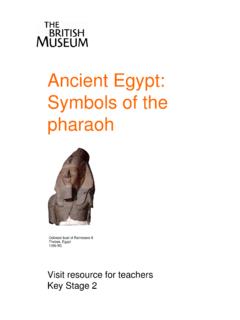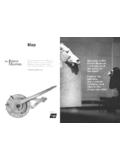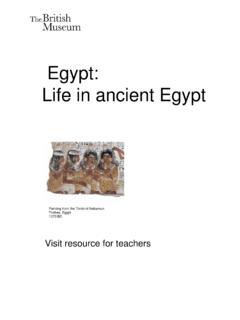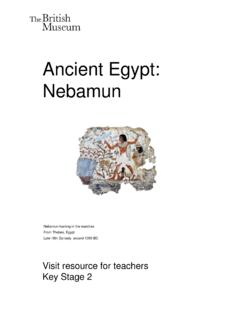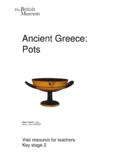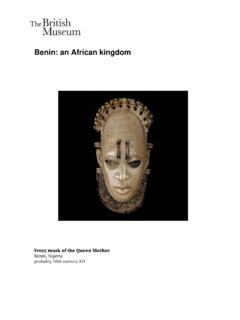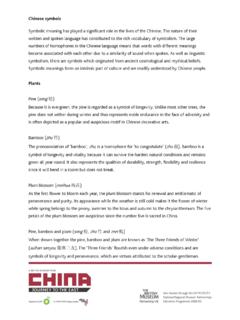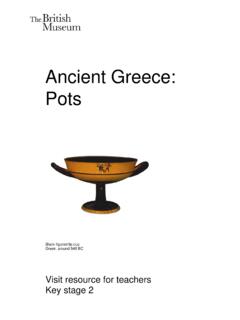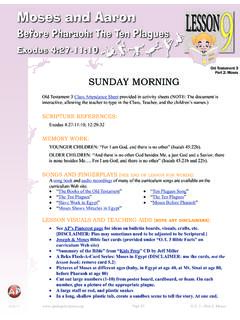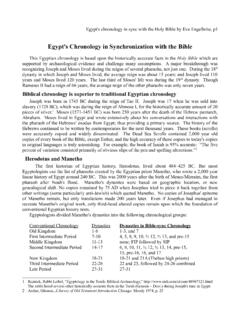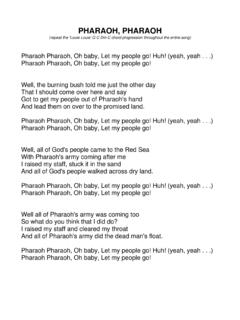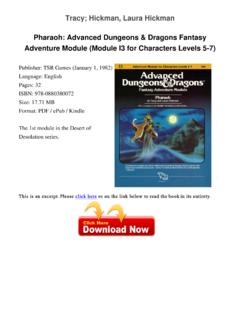Transcription of Ancient Egypt: Symbols of the pharaoh
1 Ancient egypt : Symbols of the pharaoh Colossal bust of Ramesses II. Thebes, egypt 1250 BC. Visit resource for teachers Key Stage 2. Ancient egypt : Symbols of the pharaoh Contents Before your visit Background information Resources Gallery information Preliminary activities During your visit Gallery activities: introduction for teachers Gallery activities: briefings for adult helpers Gallery activity: Symbol detective Gallery activity: Sculpture study Gallery activity: Mighty Ramesses After your visit Follow-up activities Ancient egypt : Symbols of the pharaoh Before your visit Ancient egypt : Symbols of the pharaoh Before your visit Background information The Ancient Egyptians used writing to communicate information about a person shown on a sculpture or relief. They called their writing divine word' because they believed that Thoth, god of wisdom, had taught them how to write.
2 Our word hieroglyphs derives from a phrase meaning sacred carvings' used by the Ancient Greek visitors to egypt to describe the Symbols that they saw on tomb and temple walls. The number of hieroglyphic signs gradually grew to over 7000 in total, though not all of them were used on a regular basis. The hieroglyphs were chosen from a wide variety of observed images, for example, people, birds, trees, or buildings. Some represent the sounds of the Ancient Egyptian language, but consonants only. No vowels were written out. Also, it was not an alphabetic system, since one sign could represent a combination of two or more consonants like the gaming-board hieroglyph which stands for the consonants mn. Egyptologists make the sounds pronounceable by putting an e between the consonants, so mn is read as men.
3 Many other hieroglyphic signs were not pronounced at all but served to clarify meanings, such as a boat following the sound sign dpt which was the word for boat. First developed in about 3250 BC, hieroglyphs were still used in the early centuries AD but gradually became less and less understood except by temple priests. By the time egypt officially became a Christian country in the fourth century AD, hieroglyphs had fallen out of use. The Egyptian language continued to be spoken, but was now written in an alphabetic script called Coptic. When the Arabs conquered egypt in the seventh century AD, they introduced the Arabic form of spoken and written language, which is still used by Egyptians today. Alongside the hieroglyphic text, the Ancient Egyptians made use of a variety of Symbols to convey information.
4 These Symbols could be in the form of a 3D object or carved as a sign into the surface of a statue or relief. Ancient egypt : Symbols of the pharaoh Before your visit Table of Symbols Ankh The ankh is a symbol of life. It was often carried in the hand. Nemes The nemes head dress is a piece of cloth pulled tight across the forehead and tied at the back, with two flaps hanging down the sides. It is worn by the pharaoh . Scarab Scarab beetles lay their eggs on a ball of dung, which is then rolled along the ground and dropped into a hole. The Ancient Egyptians associated this with the sun moving across the sky each day. In addition, the beetle grubs hatching from the ball of dung were a sign of rebirth. Uraeus The uraeus is a rearing cobra with a flared hood. A symbol of protection, it guarded the gates of the underworld, warded off the enemies of the royal family and guided the dead pharaohs on their journey through the underworld.
5 The uraeus was worn on the forehead. Cartouche A cartouche is an oval shape placed around the names of royal people in hieroglyphic inscriptions. It symbolized the pharaoh as a ruler of all that the sun encircled. Lotus flower Like the sun that rises in the morning and sets in the evening, the lotus flower blooms in the day and closes each night. The lotus was a symbol of rebirth, the renewal of life and the promise of everlasting life. Ancient egypt : Symbols of the pharaoh Before your visit Resources British Museum websites Explore Explore is an online database of over 5000 objects from the Museum's collection. To investigate objects from Ancient egypt use the Explore option on the homepage of the British Museum website: Ancient egypt website This is an interactive learning and information website with text, images and maps relating to a range of key themes.
6 It includes a wide variety of online activities for students and an area for teachers providing guidance and ideas for the classroom. Books For adults M, Collier, Manley, B., and Parkinson, R., How to Read Egyptian Hieroglyphs: a step-by step guide to teach yourself, British Museum Press 1998. Davies, , Reading the Past: Egyptian Hieroglyphs, British Museum Press, 1987. For children Mar e, Marcel, British Museum Pocket Dictionary of Pharaohs and Queens, British Museum Press, 2005. Parkinson, Richard, British Museum Pocket Guide to Hieroglyphs, British Museum Press, 2003. Ancient egypt : Symbols of the pharaoh Before your visit Gallery information Room 4 is the Egyptian sculpture gallery. It contains examples of monumental sculpture from temples and tombs. The gallery contains a number of statues of pharaohs and Ancient Egyptian deities (gods and goddesses) together with monumental pieces of stone architecture such as columns and carved wall reliefs.
7 At the north end of the gallery are a range of massive stone sarcophagi (bases and lids). The present arrangement of sculptures runs chronologically from the south to the north end of the gallery. The Rosetta Stone is situated, out of chronological order, at the centre of the gallery. What is it like to visit this gallery? Room 4 is a main route to other parts of the British Museum. Students should be aware of this so that they can ensure that they do not block pathways themselves or with their possessions. Many of the objects are displayed on low plinths and most of them are not behind glass. The Egyptian sculpture Touch Tour for visually impaired visitors operates in this room although all other visitors are requested not to touch the objects. The gallery gets particularly busy in the centre around the Rosetta Stone where visitors cluster to observe the Stone or cross the gallery on their way to the Greek galleries.
8 It is however, possible to find some quiet, empty spaces by the side walls of the galleries and a pre-visit will enable you to identify areas where you may gather the whole class or position groups to observe a particular object. Case Numbers Please note that case numbers are usually small, white and high up on the glass. Ancient egypt : Symbols of the pharaoh Before your visit Preliminary activities General introductory activities Locate the area covered by Ancient egypt in an atlas and look at the modern countries which currently exist in this region of the world. Discuss the role of the pharaoh in Ancient egypt . Revise the names and dates of some famous pharaohs. Compare their role to that of other kings and queens which the students are familiar with from the past or the present.
9 Look at the pharaoh section of the Ancient egypt learning site ( ) to find out about the role of these Ancient rulers. Look at objects from Ancient egypt on Explore. Search in particular for examples of statues. Activities to support gallery activities Look for examples of modern Symbols such as safety Symbols , food label Symbols , road sign Symbols or religious Symbols . Talk about what the Symbols represent and where they are being used. Use the symbol sheet included in the background information section to familiarize the students with a range of Ancient Symbols and their meaning. Look for examples of statues in your local area. Discuss issues such as pose, material and relative size so that the students are familiar with these concepts before the visit. Look at the pharaoh section of the Ancient egypt learning site ( ).
10 To find out about the role of these Ancient rulers. Ancient egypt : Symbols of the pharaoh During your visit Ancient egypt : Symbols of the pharaoh During your visit Gallery activities: introduction for teachers The gallery activities are a set of activity sheets which can be used by students working in Room 4. The sheets can be used as stand-alone activities or you may wish to develop work around particular sheets as suggested in the before and after sections of this resource. Where case numbers are indicated on a sheet, these are usually to be found marked in white numbers high up on the glass of that particular case. You are welcome to select the activities which are most appropriate for the focus of your visit and adapt sheets to meet the needs of your students. Each activity is designed to support the students in looking at, and thinking about, objects on display in the gallery.
